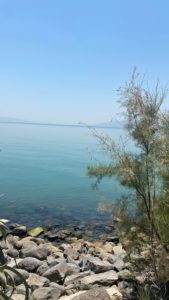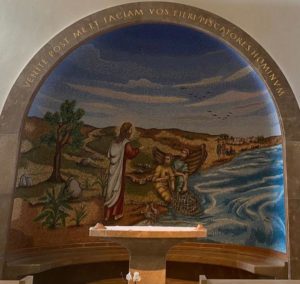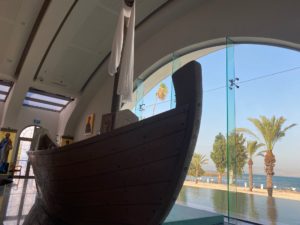
The Sea of Galilee
Andrew, like his brother Simon, hailed from Bethesda and resided in Capernaum, a village on the shores of the Sea of Galilee, where he worked as a fisherman. After the miraculous first catch of fish, he, along with the other three fishermen who became disciples, heard Jesus calling him and “leaving everything behind, followed him” (Luke 5:11). However, this wasn’t his first encounter with Jesus. Sometime before, while he was a disciple of St. John the Baptist at the Jordan River in Judea, he and another unnamed disciple spent a day with Jesus after hearing from St. John that Jesus was the Lamb of God. His initial generosity, leaving his home for a while to assist John, facilitated his prompt response to Jesus. He was the first disciple called by Jesus and brought his brother Simon to the Lord, saying clearly, “We have found the Messiah, which means Christ, and led him to Jesus” (John 1:40-43). St. Matthew and St. Mark present a different version, with the two brothers being called simultaneously: “As he walked by the Sea of Galilee, he saw two brothers, Simon, who is called Peter, and Andrew, his brother, casting a net into the sea, for they were fishermen. And he said to them, ‘Follow me, and I will make you fishers of men’” (Matthew 4:18-19; Mark 1:16-17). The Gospels also tell us that, along with Philip, Andrew brought forth several Greeks who wanted to “see Jesus” (John 12:20-28). We can see, therefore, that he was a generous disciple who magnanimously dedicated his time to assisting St. John the Baptist. He was inclined towards faith, recognizing Jesus as Messiah shortly after meeting Him. He demonstrated his apostolic nature by bringing Peter, the Greeks, and the boy, as we shall see below, to Jesus. Lastly, he was ready to wholeheartedly devote his life to Jesus.

The Calling, altar in Hotel Magdala, Israel
Although he had been present for many miracles, one in particular stands out where his contribution was vital: the multiplication of the loaves and fishes. While this miracle is the only one shared by all four Gospels, it’s only in John’s Gospel that Andrew is identified as the disciple who brought the loaves and fishes that Jesus used for the miracle. “One of his disciples, Andrew, Simon Peter’s brother, said to him, ‘There is a boy here who has five barley loaves and two fish, but what are they for so many?‘” (John 6:1-15). Here we see Andrew’s persuasive skills in convincing the boy to give his food to Jesus and his realism in recognizing that human resources were insufficient to feed a crowd of over 5,000 with such a small amount of food. The fact that Andrew’s name is mentioned several times by St. John the Evangelist, suggests that the evangelist was the unnamed disciple to St. John the Baptist mentioned above, and he was likely the same John who was united to Andrew by friendship as they lived in the same village and shared the same occupation.
Returning to John’s account, he specifies that they were barley loaves, though he doesn’t mention the type of fish given to Jesus. This can be deduced from the Greek text of John’s original narrative. He uses the word “opsaria” (John 6:9 in the original Greek, meaning small fish) instead of “ichthyes” (fish) used in the other Gospels. This word comes from “optos,” which means a condiment for food and is especially used for salted and dried fish (Strong’s Dictionary, 2007). Among the fish species in the Sea of Galilee, only one remains small in size as an adult: the Galilee sardine, Mirogrex terraesanctae (Num, 1989). It’s a pelagic fish that lives near the lake’s surface in large schools and averages about 14 cm in length (fishbase.org). It’s an indigenous and endemic species of the lake, as expressed by the Latin word “terraesanctae,” meaning ‘of the Holy Land,’ and it only lives in the country sanctified by Jesus. In addition to this reason, there’s evidence that this salted fish was a common food source for the population since it was caught seasonally and in large quantities, allowing for its salt to preserve it (Num, 1989). Furthermore, there are archaeological remains of the salted fish industry in Magdala, a city on the shores of the Sea of Galilee, which had a saltwater river (González Echegaray, 2000). Lastly, in practice, it would have been nearly impossible to feed such a large crowd with fresh fish, as it wouldn’t be feasible to set up a large number of fires to cook so many fish in an open area described in the Gospels.

Duc in Altum Church, Magdala
Contrary to his brother Simon, the Gospels provide only positive information about Andrew. He promptly followed Jesus, spoke enthusiastically about Him, possessed the ability to convince others, was generous, attentive to details, and cultivated “a relationship of genuine familiarity with Jesus, conscious that only in Him can we find the ultimate meaning of our life and death” (Benedict XVI, Audience, June 14, 2006). However, his brother Simon Peter was the first Pope, directly appointed by Jesus because despite his mistakes and sins, he always recognized them and said, “Lord, you know everything; you know that I love you” (John 21:17).
By Father Alfonso Sánchez de Lamadrid Rey
